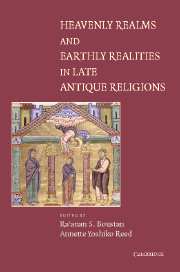Book contents
- Frontmatter
- Contents
- Preface
- List of Contributors
- Introduction: “In Heaven as It Is on Earth”
- PART ONE BETWEEN EARTH AND HEAVEN
- 1 The Bridge and the Ladder: Narrow Passages in Late Antique Visions
- 2 “Heavenly Steps”: Manilius 4.119–121 and Its Background
- 3 Heavenly Ascent, Angelic Descent, and the Transmission of Knowledge in 1 Enoch 6–16
- 4 “Connecting Heaven and Earth”: The Function of the Hymns in Revelation 4–5
- 5 Working Overtime in the Afterlife; or, No Rest for the Virtuous
- PART TWO INSTITUTIONALIZING HEAVEN
- PART THREE TRADITION AND INNOVATION
- Select Bibliography
- Index
1 - The Bridge and the Ladder: Narrow Passages in Late Antique Visions
Published online by Cambridge University Press: 14 July 2009
- Frontmatter
- Contents
- Preface
- List of Contributors
- Introduction: “In Heaven as It Is on Earth”
- PART ONE BETWEEN EARTH AND HEAVEN
- 1 The Bridge and the Ladder: Narrow Passages in Late Antique Visions
- 2 “Heavenly Steps”: Manilius 4.119–121 and Its Background
- 3 Heavenly Ascent, Angelic Descent, and the Transmission of Knowledge in 1 Enoch 6–16
- 4 “Connecting Heaven and Earth”: The Function of the Hymns in Revelation 4–5
- 5 Working Overtime in the Afterlife; or, No Rest for the Virtuous
- PART TWO INSTITUTIONALIZING HEAVEN
- PART THREE TRADITION AND INNOVATION
- Select Bibliography
- Index
Summary
The topic of this symposium and book, “in heaven as it is on earth,” is provocative and paradoxical. We assume that the Beyond – be it heaven, hell, or outer space – is a place different from ours. In narrations, this difference is objectified as a physical boundary between the here and there; when traveling from here to there, we must cross this boundary.
Historians of the ancient Mediterranean are familiar especially with one boundary that, in countless narrations, delimits the Beyond from our world: a river. From Mesopotamia to Dante, through Homer and Virgil, any visitor to the other world either has to cross the river or, as Odysseus does exceptionally, to stop on our side and somehow call the souls over here. And, from Mesopotamia to Dante, if one needed to cross the river, one had to persuade a ferryman, Urshanabi in the epos of Gilgamesh, Humut-tabal in a Neo-Assyrian vision, or Charon in Greece and Rome or in Dante. The obvious alternative to a ferryman, a bridge, does not appear before the late sixth century c.e., at least inside our cultural area, although bridges are much older in our world. This is surprising and needs an explanation.
An obvious answer would be this: In the cultures of the ancient Mediterranean world, the Beyond is never on exactly the same level as we are. The world of the dead – Hades, Orcus, hell – is somehow below, as heaven is above.
- Type
- Chapter
- Information
- Publisher: Cambridge University PressPrint publication year: 2004
- 2
- Cited by



